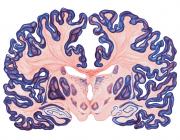Beyond a relay nucleus: neuroimaging views on the human LGN.
Publication Year
2006
Type
Journal Article
Abstract
The lateral geniculate nucleus (LGN) is the thalamic station in the retinocortical projection and has traditionally been viewed as the gateway for sensory information to enter the cortex. Here, we review recent studies of the human LGN that have investigated the retinotopic organization, physiologic response properties, and modulation of neural activity by selective attention and by visual awareness in a binocular rivalry paradigm. In the retinotopy studies, we found that the contralateral visual field was represented with the lower field in the medial-superior portion and the upper field in the lateral-inferior portion of each LGN. The fovea was represented in posterior and superior portions, with increasing eccentricities represented more anteriorly. Functional MRI responses increased monotonically with stimulus contrast in the LGN and in visual cortical areas. In the LGN, the dynamic response range of the contrast function was larger and contrast gain was lower than in the cortex. In our attention studies, we found that directed attention to a spatial location modulated neural activity in the LGN in several ways: it enhanced neural responses to attended stimuli, attenuated responses to ignored stimuli, and increased baseline activity in the absence of visual stimulation. Furthermore, we showed in a binocular rivalry paradigm that neural activity in the LGN correlated strongly with the subjects' reported percepts. The overall view that emerges from these studies is that the human LGN plays a role in perception and cognition far beyond that of a relay nucleus and, rather, needs to be considered as an early gatekeeper in the control of visual attention and awareness.
Keywords
Journal
Prog Brain Res
Volume
155
Pages
125-43
ISSN Number
0079-6123
Alternate Journal
Prog. Brain Res.
PMID
17027384

